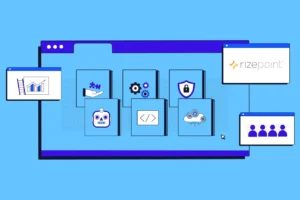
State Leaders Discuss a Way Forward at SHEEO Conference
MINNEAPOLIS—Concerns about the Trump administration’s crackdown on higher education have loomed over a number of conferences this year. But as a group of just over 600 state officials, policy analysts and nonprofit leaders gathered last week in an old train depot–turned–Marriott hotel for the annual State Higher Education Executive Officers Association conference, a different feeling was in the air.
This time, leaders still acknowledged the president’s view of colleges and universities as “the enemy,” but they expressed confidence in the mission and power of academia in democracy. They voiced cautious optimism in the future of America’s colleges and were hopeful that with concrete responses, universities could prevail despite what some have described as a full-on attack.
Bryce McKibben, a longtime higher ed policy expert and senior director at the Hope Center at Temple University, closed the event Thursday morning with a call to action.
“For the last nine months, since we first knew that a radically different policy environment was coming to Washington, D.C.—we can be honest—the higher education community has struggled to grasp the stakes of what our colleges and our students are facing,” he said, acknowledging the exhaustion in the room. “[But] this is the time for us to speak up. We have to challenge the disinformation and the false narratives about higher education. We have to protect our vulnerable students, our faculty. We can’t comply in advance.”
When asked what gives him hope, McKibben said it’s state higher education officials.
“If this current environment shifts, if there’s a break in the fever, the state examples that have been made, the state leadership that has been shown … will set the example for a new way of doing things,” he said.
Over the course of the four-day conference, attendees connected with fellow self-identified higher education nerds from across the country and heard from a top Education Department official as they discussed everything from improving dual-enrollment and transfer programs to better supporting rural learners and improving education access.
Here are three takeaways from the event.
Must Change Perceptions of Value
A key theme throughout the conference was that state systems and institutions need to actively bridge a disconnect between what data and public perceptions say about the value of a higher education degree. To do so, many speakers said, colleges must find new and innovative ways to communicate.
“We can’t rely on the same messages to defend higher education’s value,” said Michelle Dimino, director of the education program at Third Way, a left-leaning think tank. “The public is telling us in the public opinion research that they have seen from present and historical data, and experiences in their own lives, that higher education has been a valuable experience and a lever for advancement. But they’re seeing it as less important when they think about the future.”
Awareness of this skepticism is nothing new, but new data from a recent Gallup report presented at SHEEO by senior partner Stephanie Marken shows that state officials need to take a more nuanced approach to the topic.
Marken said she explains the situation by comparing education to medicine.
“The health-care system in the United States is broken … but I can still also believe that if I go to my doctor, I’ll be healthier,” she said. It’s similar in higher ed: “There’s this belief that the industry might be faltering, inaccessible to many Americans, but I [can] still believe it’s the surest path for me to pursue a postsecondary pathway.”
This is particularly true among low-income and first-generation college families, she added.
Multiple state systems shared how they are using new return-on-investment metrics to help show that undergraduate degrees will still be a worthwhile investment for years to come.
In Arkansas, for example, state data experts are comparing the median earnings of non-degree-holders to those of graduates with an associate or bachelor’s degree—much like Congress’s attempt to hold colleges accountable through a new earnings test. The main difference is that Arkansas judges the income level over time.
By factoring in not only income levels but also the average cost of a degree after financial aid, they’re creating a database that shows students how long it takes to pay off debt and earn more than they would straight out of high school in various degree programs.
“We see the value of higher ed for our students, but we needed to prove it,” said Nick Fuller, chief finance officer of the Arkansas Division of Higher Education. “We wanted to put some data behind it.”
A leader from Montana later shared how in collecting similar data and analyzing the public perception of college, her state has identified that a lot of the concerns people raise come from hearing the stories of people who don’t finish.
“What we have heard from Montanans is that they’re talking to their peers, they’re talking to people they know, and if the people that they know have had poor experiences in higher education, that’s where they’re getting their information from, and that’s how they’re making decisions,” said Crystine Miller, director of student affairs and student engagement for the Montana University System. “Barriers to access and to college are real and perceived. And I think we need to take both of those side by side.”
Meeting Workforce Needs
In addition to focusing on how to address basic needs like food, shelter and childcare and simplify processes like credit transfer to help students complete college, much of the conference also delved into students’ paths after graduation.
SHEEO surveys have consistently shown workforce development as one of the top priorities for state directors and commissioners. But ensuring students have the skills necessary to find employment and fill the needs of the local market has proved increasingly difficult in a quickly evolving landscape.
“The knowledge economy that we have all been in for at least a half century or so, it’s ending, and we are entering a new economy. But we don’t yet know what it will be defined as,” said Aneesh Raman, chief economic opportunity officer at LinkedIn, in a keynote session.
“There’s a righteous discussion about how we aren’t meant to train workers, we’re here to build minds, and I think that’s right,” Raman added. “But what’s exciting is those two things are about to merge, given what AI is going to do in terms of the tasks it’s taking. The humanity in us is going to become a more and more competitive attribute at work.”
Nicole Smith, chief economist at Georgetown University’s Center on Education and the Workforce, opened the first night of the conference by saying the way to help ensure proper college-to-career pathways in this changing economy is through data.
“Often, our programs are not keeping pace with the evolving demands on the labor market, [leaving] graduates underemployed and employers struggling to find and start the talent that they need,” she said. “The good news is we now have unprecedented access to data on wages, employment, skill and demand … [and with it] we can create clearer, more equitable pathways for classrooms to careers.”
Panelists and commenters in the audience shared various ways their states are increasing collaboration between the departments of education and labor and using reports like those from CEW to find solutions.
But Smith warned that using data to meet the needs of today’s complex labor market will become difficult if that data disappears. The Trump administration has laid off nearly half the Department of Education’s staff, including a number of employees from the National Center for Education Statistics, the department’s key research arm, and many fear it will lead to a decrease in data collected.
“We need to keep having these conversations, because we find that every day, many of the opportunities to make those connections are whittled away as we take away funding from any of the data programs that we use,” she said.
State-Federal Partnerships Key
The key to maintaining databases, grant programs and federal student support services that higher education leaders depend on, multiple sessions of the conference suggested, will be acknowledging the political climate and working with policymakers at both state and federal levels.
Over the last seven months, the Trump administration has made a series of sweeping changes to higher ed policy and launched investigations against colleges and universities for allegedly not adhering to them.
James Bergeron, deputy under secretary of education, addressed some of these changes at SHEEO. He focused primarily on the One Big Beautiful Bill Act and its new Pell Grant for students in short-term certificate programs—which he described as a chance for state governments to be in control and determine what qualifies as a high-skill, high-wage or in-demand careers.
He also touched briefly on the bill’s new caps to graduate student loans, but was quick to say, “If you talk to institutions at all, you know folks are really concerned about the impact of the bill on graduate education programs,” and “I don’t want to talk about that other than to say that this is obviously a huge change that we’ll have to do.”
Audience members remained largely quiet. Some leaned over and whispered remarks to one another. But when Bergeron briefly referenced the upcoming budget for fiscal year 2026 and compared the president’s proposal to the Senate’s proposal, which protects several programs for low-income and first-generation students that Trump wanted chopped, a few audience members clapped. That sound steadily grew.
Bergeron chuckled and quickly moved on.
He did not accept any questions, as all other speakers had. A SHEEO official said this was because the conference was tight on time and it was normal for department officials not to accept public comment at large events.
State lawmakers who led a different session, however, did take questions. They largely agreed that the key to moving forward will be civil conversations between policymakers and education advocates.
“There are disagreements. There are supposed to be disagreements,” said Minnesota state senator Aric Putnam, a Democrat. “Democracy is a technology for managing attention, not getting rid of it.”
Dennis Olson, commissioner of the Minnesota Office of Higher Education, later emphasized the need for continuous conversations.
“Whether things are going on within the state, locally or federally, we have to assume that role of being the key policy experts in the room … [is to] educate, re-educate, remind and update our legislators to make sure they are independently aware of what’s going on within the field,” he said.
Source link



